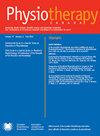Pelvic Health Content in Canadian Entry-To-Practice Physiotherapy Programs: An Online Survey
IF 0.8
4区 医学
Q4 REHABILITATION
引用次数: 0
Abstract
Purpose: Pelvic health physiotherapy is an emerging and sensitive area of practice that offers effective conservative treatment for pelvic health conditions. Canadian entry-to-practice curriculum guidelines accord programs considerable flexibility regarding incorporating pelvic health content, which may lead to differences between programs and diverse levels of competence among new graduates. The purpose of this study was to determine the nature and extent to which pelvic health content is incorporated in entry-to-practice physiotherapy programs in Canada. Method: We conducted a descriptive cross-sectional e-survey of representatives from Canadian entry-to-practice physiotherapy programs. Results: Ten out of 15 Canadian programs participated. Programs incorporated pelvic health content throughout the required curriculum ( n = 9) and in optional courses ( n = 6). All participating programs covered musculoskeletal-related conditions, urinary incontinence, and pelvic pain conditions, and included anatomy and physiology, clinical reasoning, subjective assessment and pelvic floor muscle training topics. Three programs trained students in internal pelvic floor techniques in elective courses. All programs covered cisgender women populations, however, transgender populations were seldom covered. Conclusions: This study provides an understanding of pelvic health curricular content that can serve as a first step towards standardizing and improving entry-level pelvic health training in Canada.盆腔健康内容在加拿大进入实践物理治疗方案:一项在线调查
目的:盆腔健康理疗是一个新兴和敏感的实践领域,为盆腔健康状况提供有效的保守治疗。加拿大实习入门课程指南在纳入盆腔健康内容方面给予项目相当大的灵活性,这可能导致项目之间的差异和新毕业生的不同能力水平。本研究的目的是确定盆腔健康内容在加拿大入职理疗项目中的性质和程度。方法:我们对来自加拿大物理治疗项目的代表进行了描述性横断面电子调查。结果:15个加拿大项目中有10个参与。项目在必修课程(n = 9)和选修课程(n = 6)中纳入盆腔健康内容。所有参与的项目涵盖肌肉骨骼相关疾病、尿失禁和盆腔疼痛状况,并包括解剖学和生理学、临床推理、主观评估和盆底肌肉训练主题。有三个项目在选修课中训练学生的骨盆底技术。所有的项目都覆盖了顺性女性人群,然而,变性人群很少被覆盖。结论:本研究提供了对盆腔健康课程内容的理解,可以作为标准化和改进加拿大入门级盆腔健康培训的第一步。
本文章由计算机程序翻译,如有差异,请以英文原文为准。
求助全文
约1分钟内获得全文
求助全文
来源期刊

Physiotherapy Canada
REHABILITATION-
CiteScore
1.90
自引率
20.00%
发文量
93
审稿时长
>12 weeks
期刊介绍:
Physiotherapy Canada is the official, scholarly, refereed journal of the Canadian Physiotherapy Association (CPA), giving direction to excellence in clinical science and reasoning, knowledge translation, therapeutic skills and patient-centred care.
Founded in 1923, Physiotherapy Canada meets the diverse needs of national and international readers and serves as a key repository of inquiries, evidence and advances in the practice of physiotherapy.
Physiotherapy Canada publishes the results of qualitative and quantitative research including systematic reviews, meta analyses, meta syntheses, public/health policy research, clinical practice guidelines, and case reports. Key messages, clinical commentaries, brief reports and book reviews support knowledge translation to clinical practice.
In addition to delivering authoritative, original scientific articles and reports of significant clinical studies, Physiotherapy Canada’s editorials and abstracts are presented in both English and French, expanding the journal’s reach nationally and internationally. Key messages form an integral part of each research article, providing a succinct summary for readers of all levels. This approach also allows readers to quickly get a feel for ‘what is already known’ and ‘what this study adds to’ the subject.
Clinician’s commentaries for key articles assist in bridging research and practice by discussing the article’s impact at the clinical level. The journal also features special themed series which bring readers up to date research supporting evidence-informed practice.
The Canadian Physiotherapy Association (CPA) is the national professional association representing almost 15,000 members distributed throughout all provinces and territories. CPA’s mission is to provide leadership and direction to the physiotherapy profession, foster excellence in practice, education and research, and promote high standards of health in Canada.
 求助内容:
求助内容: 应助结果提醒方式:
应助结果提醒方式:


